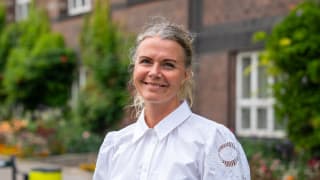Collaboration and community engagement: forward-thinking from Ontario
Around the world, destinations have shifted to hyper-local focus as they plan for recovery. We spoke to Lisa LaVecchia, CEO at Destination Ontario, to understand how she anticipates the tourism industry evolving and what they're doing to prepare.
It’s great that you’re able to join us, Lisa. I want to start by looking forward. There’s a huge potential for reinvention in the COVID-19 pandemic, and to rethink industry standards which have just become the norm. How are you reimagining your own role? What impact will this have on your strategy for the coming years?
“Reinvention” is definitely the right term. The impact of COVID-19 has been devastating for so many people, but we are already seeing the world of travel in new light. So much of our strategy is about people’s behaviours, what they want and need and how they travel. That’s all changing. Even when this is all over, and people are travelling the world again, we can see that it’s likely going to be very different. Whether it’s physical distancing, health and safety checks, wearing personal protective equipment – we’ll need to not only be cognisant, but to make sure our destinations provide safe and accommodating products and experiences. Our strategies will reflect that.
How is the role of state marketing changing to support your regional stakeholders and local city DMOs?
Destination Ontario has always had a collaborative relationship with our regions and DMOs – we’ve always seen ourselves as a hub that connects everyone from all areas of the province. You know, just last year one of our main speaking points at conferences and on panels was the “Power of Partnership” – that we are so much stronger together and with shared talent and shared expertise we can do great things. So, the idea of collaboration is not new, but how we collaborate, that of course will be different. And of course, now more than ever, we need to work together.
As a Provincial Marketing Organization, one of our main roles will continue to collaborate with our partners and stakeholders and really support local tourism organizations with whatever they need to succeed.
Many destinations are moving to a hyper-local focus as they begin recovery. How are you anticipating your own focuses changing as you begin your own recovery journey?
Definitely, we’re starting hyper-local. Ontario has already begun the process of gradually reopening businesses, services and public spaces on a regional basis. That is refreshing news. But even as progress has been made in the fight against COVID-19, it remains important that people continue to practice physical distancing and to maintain travel within local areas.
So, this is a great opportunity for people to really discover and re-discover all their local communities have to offer. Just get out and go to a local restaurant or café or visit an attraction you maybe haven’t been to in a long time. Be safe, be responsible, but be active in your home town.
Our role will be to get word out there of what great things you can do in your local community. Certainly, our social channels are very active on spreading the news and profiling all the great things there are to do. One of Destination Ontario’s great talents is to inspire people to have pride of place and to really see the beauty in our own backyards.
You mentioned during the City Nation Place Americas conference that though you’ve always been very partner-driven, that model is having to evolve to put rebuilding and recovery as a core priority. Can you explain more about these changes?
As I mentioned earlier, Destination Ontario is a great believer in the Power of Partnership. We’re always stronger together. And, as noted, collaboration is now more important than ever before. What is different, though, is that in the wake of COVID, we have partners in dire need of support who may not have the resources or the tools they need to rebound. That is very important to remember – some businesses simply may not come back.
But if we work together and communicate effectively, we can really make a difference. Whether it’s helping with resources, expertise, marketing efforts or advice, or even connecting people together to share best practices, I believe that if we work together, we can rebuild and recover and perhaps be even better than we were.
Destination Ontario has had a huge focus on community engagement – both with the #DreamON campaign, and with an emphasis on feel-good positive stories from the region to show how people are getting back on track. Do you have a tip for other destinations looking to increase engagement with their residents?
Yes, #DreamON was a campaign of one of our Regional Tourism Organizations and is a good example of how we can help each other share those positive stories. I would say that people really connect to stories with heart. When we look at an ad or a campaign or audience engagement, we always start with the passion. In fact, we started calling ourselves “passionistas” – people who are passionate about travel and love to share that passion with others. So, if you have a product or an experience that you think is cool or that people will like, you need to not only show them what they’ll like about it, but why they’ll like it, and you often do that by sharing your own passion and inspirations.
It states in your 2018-2021 strategy book that you were increasing your focus on data-driven consumer insights. How have you achieved this? How are you looking to continue to evolve this in the future?
This has been a major advancement in our work at Destination Ontario. I’m very proud of the work we’ve been doing in this field because I believe it will be a game changer in how our province rebounds from this crisis. We conduct tourism research that provides market intelligence and consumer behaviour analysis to enable tourism operators to make informed business decisions, be flexible to changing landscapes and deliver results for tourism businesses.
Of course, we also must measure results, understand where the organisation has succeeded and where it must continuously improve and bring value to the consumer. Our Data and Insights team focuses on measurement, campaign performance and insights to inform marketing strategies. This way we keep learning and refining our strategies to meaningfully connect with visitors while maximising value for money.
To go back to your question about partnerships, well, this is something that we do for our partners. We share this information in regular reports that provide people with intel that will guide their recovery efforts.
It also suggests that you’re adopting a design thinking approach to put visitors first – has this impacted on your strategy and approach?
Ah yes, Design Thinking. It absolutely has. The basic premise of design thinking is you put the user at the heart of your design and create solutions that make life easier. Instead of saying, “we have a great province with all this great stuff, you should come here!”, we look at what the visitor wants. What are they passionate about? What drives them. What inspires them. And we find a way to connect that very potential traveller with an experience that really excites them. That’s another great advantage of mining the data we do – we get to know our consumers and offer them something that we know they’ll love.
This will be more important than ever. It’s not just what they’ll love, but what they’ll need in order to feel comfortable and safe when travelling.
Lastly, as one of our jurors, do you have any tips for a prospective entrant for the City Nation Place Awards?
Going back to your question about engagement, I would say tell us the stories that really speak to your passion. Yes, it’s important to tell us what you achieved and how you achieved it… but more important is why. In fact, start with why. When you tell us why you set out on your initiative, what drove it, what’s behind it – that really speaks to the heart of it. Passion is contagious. Be a passionista.
Amazing. Thank you for sharing that with us, Lisa.
Interested in entering the City Nation Place Awards? Find out more here.
Related reading:
Hall of fame: 15 of the best place marketing and place branding campaigns
Has the pandemic killed soft power?
The politics of space, culture, and placemaking in post-COVID place branding
Nine expert tips to prepare for recovery in cities, nations and regions









